- Home
- William Shatner
Up Till Now Page 26
Up Till Now Read online
Page 26
I did, and this time a woman answered. When I asked for this man she explained, “I’m sorry, but he committed suicide two days ago.” Committed suicide? It was devastating. I’d had suicidal thoughts myself. But as I tell people suffering from this condition, time is the best treatment. They will become habituated. I have, they will.Please, listen.
So. As I was writing, I was supposed to direct the fourth Star Trek film, The Voyage Home. But because I had obligations to T.J. Hooker, I couldn’t do it. Leonard also directed this one. As we had occasionally in the past, in Star Trek IV we went back in time. A deadly probe was approaching the Earth, sending out strange signals. These high-pitched beeps turned out to be an attempt to communicate with whales, which had long been extinct. So we were assigned to return to Earth of the 1980s to capture two whales and bring them home to the future. Spock, of course, was completely out of his century and had great difficulty dealing with the illogic he found in 1980s San Francisco. Once, for example, after he’d attracted too much attention with his odd behavior I explained, “Oh him? He’s harmless. Part of the free speech movement at Berkeley in the sixties. I think he did a little too much LDS.”
In another scene my love interest, Dr. Gillian Taylor, asked Spock, “Are you sure you won’t change your mind?”
To which he replied logically, “Is there something wrong with the one I have?”
Chekov had a similar problem. An FBI agent interrogating him asked, “Name?”
“My name?” Chekov asked.
The agent replied sarcastically, “No, my name.”
Chekov was stumped. “I do not know your name.” “You play games with me, mister,” the agent threatened, “and you’re through.”
Chekov smiled. “I am? May I go now?”
The film cost $25 million to make and earned almost $150 million. It was by far the highest-grossing Star Trek film—which certainly made it a difficult movie to follow. And it was my turn.
I began by settling on a concept: the crew of the Enterprise goes in search of God. And instead we find the devil. I wanted Kirk and Spock and Bones to go to hell. Filmically. I wanted to explore the whole philosophical question of God and the devil and man’s relationship to their worship, a subject that had fascinated me for a long time. And here I was being given a clean slate. What do you want to do, Shatner? God and Star Trek. That’s a jaw dropper. I had it all worked out in my mind, McCoy falls into the grip of the devil. Spock and Kirk go to hell and are able to get out through the tunnel of Hades and are running for the safety of the Enterprise when we hear McCoy calling for our help. And we have to turn back out of love for our partner. That was my idea: Kirk and Spock explore Dante’s Inferno. I could visualize us crossing the burning River Styx, pursued by living gargoyles, fleeing into the depths of collapsing cities. The thought of creating hell on film was incredibly exciting to me. Heaven and hell, love and hate, God and the devil, that was the movie I wanted to make. I wrote a three-page outline and submitted it to Paramount. And they loved it. Yes, this is damn good. This is what we want to do.
It had to be approved by Roddenberry. He turned it down. I tried to do a God story, he said. It’s not going to work. You alienate everybody. Nobody knows what God is, everybody has a different concept of God. Yes, the studio agreed with him, this is what we don’t want to do.
No God story? I couldn’t believe it. I wanted to do a God story. Then someone suggested, what if an alien thinks he’s the devil? Maybe that would work. Yes, the studio agreed, if an alien thinks he’s the devil we can do it.
Roddenberry agreed, as long as it was an alien and not really the devil.
I had my story. We go in search of God and find an alien who claims to be the devil and we believe he’s the devil but he’s not the devil. That would work. What I realized only after the movie was completed and I’d made the first of many compromises was that I’d already destroyed my concept. It was no longer God and the devil; it’s a psycho alien who is a devil worshipper. Every step of the way in making a movie there are compromises and this was my first one. But at least I had my basic plot.
And then I created my Big Bang ending. Now this was really going to be spectacular. Kirk was going to be running up a mountain to escape and the alien-devil’s minions were going to come out of Hades in pursuit. What a concept! I knew they couldn’t simply come out of the ground—they would be thrust out like rocks from a volcano. Yes! Smoke and fire streaming out of their mouths. I could see it. I described it to the special-effects people. They loved it. Smoke and fire! Everybody loved it. “How many rock people can I have?” I asked.
“We’ll get you ten,” they said.
Unbelievable! That’s better than the Furies. They’re smoking and flames are shooting out of their mouths and they’re chasing Kirk. They’re four-legged animals. I drew up some sketches of these rock men exploding. This finale was going to be bigger and better than anything ever seen on Star Trek. So I’ve got a great beginning, a strong story, and a great ending. I know I can fill in the rest. And I’m going to direct it. This is going to be the start of the next phase of my career.
I was enthralled with the entire process of directing a $30 million major motion picture. On a film set the director isn’t God—he’s the one who tells God to run across the parking lot, leap onto the hood, and grab hold of the wipers and hold on.
Until we actually began filming I don’t think I ever imagined how different it is directing a television program and a motion picture. When I directed Hooker, for example, I had to move in close; if I widened my frame more of the background was included, meaning it had to be lit or cleared, all the traffic had to be stopped, people on foot had to be held back. It meant getting permits and releases, staying away from identifiable product signs. Instead, we’ll put the camera right here and do a close-up.
Let me give you an example: imagine a very simple scene. Romeo says to Juliet, “I love you.” Juliet looks at him angrily and replies, “Oh please. Do you think I’m a fool?” Good dialogue. If we were shooting it for television we’d put Romeo and Juliet a few feet apart, get a two-shot of the quarreling lovers together, and then shoot close-ups of each of them separately. Simple and quick.
But the director of a big-budget film would do it very differently. “To symbolize the distance between them let’s go to Switzerland and put each of them on the summit of a mountain in the Alps. We’ll shoot it peak-to-peak at sunset. Let’s make it 70mm. And let’s get Brad Pitt and Angelina Jolie. Then we’ll hire John Williams to do the original music.” And the producers are in awe of his brilliance. The Alps! Why didn’t we think of that? And they will move five hundred people to Switzerland to get that shot. For a director the sense of power in incredible. Whatever you conceive in your imagination, whatever you dream, five hundred people are ready to make it happen.
Unfortunately, that was not my experience on this film. The plot was somewhat complex: it takes place in Stardate 8454.130. Kirk is on vacation, climbing El Capitan mountain in Yosemite when the Enterprise is dispatched on an emergency mission to rescue hostages on a desolate planet. The kidnapper is a Vulcan, Spock’s half-brother, who is using the hostages to lure a starship to Nimbus III so he can use it to cross the Great Barrier—the final frontier—and reach the mythical planet Sha Ka Ree, which is inhabited by a Godlike entity. Perhaps it even is God. Kirk agrees to travel there with him, and on that planet they encounter this entity. Eventually Kirk battles this alien—this is the battle with the rock men from hell— which is destroyed with the help of a Klingon commander who followed the Enterprise there to kill Kirk.
A week before we started shooting I still hadn’t seen the rock men suits. This was my big ending, the whole film was building to that scene, I wanted to see them. Don’t worry, I was told, they’re coming. And then I got a cost breakdown. They were going to cost $350,000 a suit. Three-point-five million dollars for ten suits? We didn’t have $3.5 million for anything. The producers told me we had to cut the budget. Okay, can I have five suits?
I could make it work with five. Okay, five suits.
We started shooting. A week passed, two weeks, I still hadn’t seen the suit. But I’m excited about it, it’s going to be great. Fire is going to come out of it. It’s going to be amazing. It’s almost ready, I’m told. Great, when? Next week. Trust me. More weeks pass, we’re shooting in the Arizona desert and we’ve got to shoot that final scene soon. I’ve planned it out, I see it in my head. It’s going to be amazing. And then they told me that, essentially, we could afford only one suit.
One suit? One fucking rock man suit? Well, I had no options. I decided I’d shoot it up close, far away, in different locations, and then we’d use movie magic to make it appear as if it were an army of devils. Okay, one. When am I going to see it? On the 17th, they promised.
But we were scheduled to shoot the scene on the 18th. They guaranteed I’d have it on the 17th, and it would be great. It’ll breathe smoke and fire. It’ll be amazing. Amazing!
On the 17th I returned from our location and the special-effects people were waiting for me. They were smiling. “It’s done and it’s fantastic. George is wearing the suit. You want to see it?”
The sun was setting behind George as he appeared. It was awful, terrible. It looked like a monster from the 1930s Flash Gordon serials. I held my temper, maybe the fire and smoke will save it. I took a deep breath and asked, “Where’s the smoke?”
And then a thin wisp of smoke curled into the air from behind a rock. I looked behind the rock and two special-effects men were crouched there smoking cigarettes and blowing smoke into a tube. I was just about speechless. We’d started with $3.5 million for ten suits and we’re down to one $350,000 suit with two men blowing smoke into a tube.
I took a few steps back and if I squinted and sort of looked at it from the corner of my eyes and if the lighting wasn’t great it did look as if it might be oozing out of the rock. Okay, all right, I stayed calm, somehow I’d make it work. I was a director! And directors always make it work. “How does the fire work?” I asked.
“Well, the fire’s a problem,” they admitted. “We tried it and it burned the stuntman’s face. So we’ll put it in the CGI. We’ll create it on the computer. We’ll just create it in editing. He’ll open his mouth and flames will come shooting out. It’ll be great. Trust us.”
There was nothing I could do. I thought I was getting Romeo and Juliet on mountaintops in the Alps, instead I was getting ALF in a playground. If I obscured him in a lot of smoke, and if we shot in dim light, maybe, just maybe I could get away with it. So the next night we all went up to the location on the side of a mountain and got everything set up. Finally, we were ready to shoot the climactic scene. Cue the stuntman. He appears and... and there’s no smoke! “Cut! Cut! Where’s the smoke? I need smoke!”
They looked at me sheepishly. “Well, we’re blowing the smoke through the tube, but the breeze is dissipating the smoke.” The breeze? They hadn’t planned for the breeze? We’re in the desert and the desert cools at night and creates a breeze. Since the beginning of time there’s been a breeze at night in the desert. Instead of a fire-breathing smoking devil, I had a ridiculous-looking guy in a leather outfit. It was useless. I didn’t have an ending. Not only didn’t I have an ending, I didn’t have my God. At one point the alien-devil sends out a shaft of light that we’re supposed to believe is God. So what does God look like? Initially I intended to use a stylized Jesus Christ–like figure but then Roddenberry made his salient point: God is different for everybody. So we also needed God.
We were going to have George Lucas’s Industrial Light and Magic create God for us. George Lucas! Just imagine George Lucas’s vision of God. And ILM did extraordinary work, it was the most creative company in the entertainment industry. I was absolutely thrilled. Maybe they could save me.
Unfortunately, they were busy working on two major pictures— and they probably were a little too expensive. So we found this guy in Hoboken, New Jersey. I’m totally serious. This was a man who’d done some impressive work on television commercials. Five of us flew to New York and met with him in his house. His wife was a five-star cook and made us a wonderful dinner. Believe me, her potatoes were the best potatoes I’d ever eaten. It’s worth going to Hoboken to eat these potatoes; believe me, no one has ever made potatoes...
Afterward he took us into his studio and created God in a tank of oil. It was a mixture of various oils swirling in a large oil lamp–like device. “If we shoot it tight,” he explained, “we can get an image...”
We were all so seduced by this great meal and perhaps some wine that we offered him the assignment. Maybe we didn’t have Industrial Light and Magic, but we did have this guy in New Jersey whose wife was a great cook.
What we should have done was use her potatoes. If we had mashed them just right it would have looked more like God than the images he created for us.
We just didn’t have the budget to put the movie I saw in my mind on film. In the opening scene in Yosemite, for example, I was supposed to be climbing a sheer cliff. I had a camera on a plateau, looking straight down three thousand feet as I climbed up. I was wearing a safety harness so it wasn’t dangerous, and as long as I didn’t look down I was okay. The problem we encountered was that because the camera films in two dimensions it was impossible to get a sense of the true height. In fact it looked like it was about six feet down. I needed to drop some rocks so the camera could follow them all the way down to give the audience a sense of the actual height, but climbers in Yosemite are prohibited from throwing stones down. I solved that by having some rubber rocks made. As I climbed up, I was going to dislodge them and the camera would track them all the way to the bottom. Unfortunately, these rubber rocks had to weigh almost nothing so they would not pose any danger to people below. In fact, they were so light that when I touched them they floated away in the breeze. I had a large pile of floating rocks. And, obviously, completely useless.
We never did find an appropriate ending. After we’d finished shooting I had to search through all the footage to find something, anything, that I could use to construct the final scene. Somehow we managed to put something together, but it was a poor compromise. From the beginning to the end the entire film was a compromise. As a result Star Trek V:The Final Frontier just wasn’t that good. I wasn’t terribly dissatisfied with it, there were some very good moments in it. The quality of a science-fiction film depends almost completely on the story and its special effects. In this film the tacky special effects actually hurt the story. Most of the reviews were disappointing, but the New York Times review was complimentary: “Scene for scene Mr. Shatner’s direction is smooth and sharply focused.” The film grossed $70 million, more than double what it cost to make; so it was profitable even if it wasn’t an artistic success.
The night we opened was one of the most glorious evenings of my life. I sat in the back of a sold-out theater watching the glow from the screen highlighting people’s heads. And they sat there entranced by my work. It was a magic trick. I’d created it out of an idea, a thought. An idea that eventually employed hundreds of people and entertained millions. My idea, my dream. And in the sense of taking a simple thought and transforming it into a complex product it was an overwhelming experience.
I loved directing, and I certainly wasn’t soured on the process. In the future I just had to be leaner and smarter. The lesson I’d learned was that the company runs on the strength and personality of the director. I had been too timid. Early on we’d spent a considerable amount of time trying to visualize God. I needed creative help but nobody came up with any ideas. The producer, rather then being helpful, took out on me whatever frustrations he was having dealing with the studio. Rather than being supportive, he was destructive. For example, I had recently seen The Wizard of Oz and in desperation I suggested that the face of God appear in a whirlwind. In front of the entire crew the producer snarled, “For Christ’s sake. I bet you saw The Wizard of Oz.”
Of course I had to admit it. But
I was furious. For no reason, except perhaps his own ego, he had humiliated me in front of the cast and crew. If he didn’t show me respect, why would any of them? What I should have said to him was, “How dare you talk to me that way. If you don’t like the idea, that’s one thing. You come up with something better.” But I didn’t have the strength of character to stand up to him. I was so intent on getting this movie made and not ruffling any feathers that I stood there and accepted his abuse.
Half of directing is politics and in my first attempt that was the aspect I’d failed. If I was going to be successful as a director, I’d learned, I had to take complete charge. And so, several years later, when I wrote and directed and starred in the feature film Groom Lake, I had almost complete control.
Do me a favor, please, don’t tell that to anybody. Let’s just keep it between us.
This was a film I wanted to make in the worst way, and that’s exactly what happened. This was a wonderful story of love and life. A dying young woman travels with her husband to Groom Lake, which is another name for Area 51, the super-secret military installation ninety miles north of Las Vegas. Investigators into UFOs and alien visitations have long maintained that the U.S. government base there is the center of our investigation into extraterrestrial activities—and that at least one alien was captured and lived there. The young couple go there to try to find some evidence that there is life beyond what we know, and that someday, in some form, they will be together again.
It was a movie about the mysteries of life and death, a film with an ambiguous but hopeful conclusion. I had a very difficult time finding the money I needed to make it. But finally a man named Charles Band, who had produced numerous C-movies, including Bimbo Movie Bash, Teenage Space Vampires, Femalien, Beach Babes from Beyond, and Horrorvision, offered to make it as a low-budget film. I guess he figured that my name attached to a science-fiction film would be enough to recoup a small investment. I initially had it budgeted at $1.5 million. If I had to squeeze everything I probably could have made it for a million. But at half a million dollars it’s almost impossible.

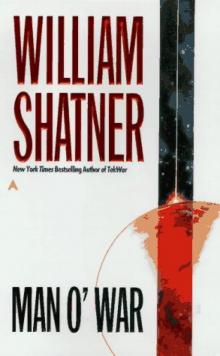 Man O' War
Man O' War Shatner Rules
Shatner Rules Leonard
Leonard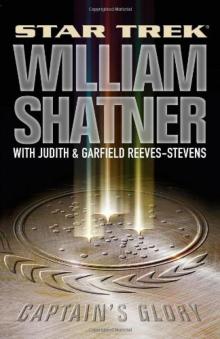 Captain's Glory
Captain's Glory Captain's Glory зпвш-9
Captain's Glory зпвш-9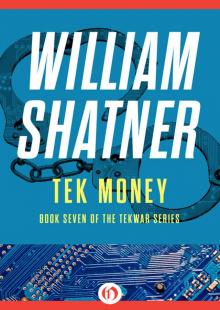 Tek Money
Tek Money Spirit of the Horse
Spirit of the Horse Tek Vengeance
Tek Vengeance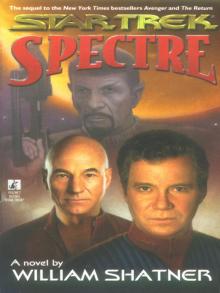 Spectre
Spectre Zero-G
Zero-G Tek Kill
Tek Kill Collision Course
Collision Course TekLab
TekLab Up Till Now
Up Till Now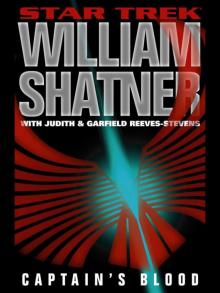 Captain's Blood
Captain's Blood TekWar
TekWar Tek Secret
Tek Secret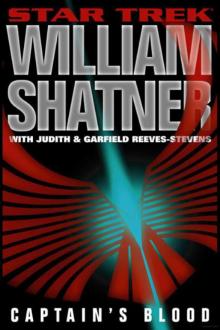 Captain's Blood зпвш-8
Captain's Blood зпвш-8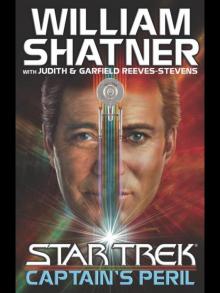 Captain's Peril
Captain's Peril Live Long and . . .
Live Long and . . .